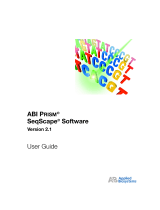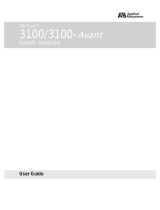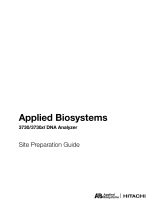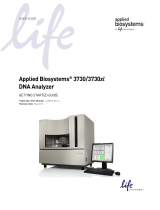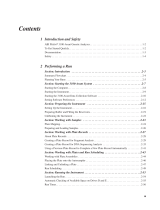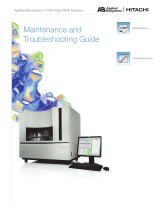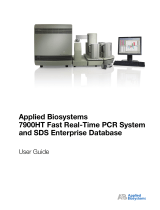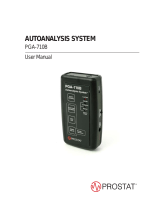Page is loading ...

SeqScape® Software
Version 2.5
User Guide


DRAFT
November 5, 2004 3:33 pm, SeqScapeTitle.fm
SeqScape® Software
Version 2.5
User Guide
Tutorial
Chapter 10

DRAFT
November 5, 2004 3:33 pm, SeqScapeTitle.fm
© Copyright 2004, Applied Biosystems. All rights reserved.
For Research Use Only. Not for use in diagnostic procedures.
Information in this document is subject to change without notice. Applied Biosystems assumes no responsibility for any errors that
may appear in this document. This document is believed to be complete and accurate at the time of publication. In no event shall
Applied Biosystems be liable for incidental, special, multiple, or consequential damages in connection with or arising from the use
of this document.
Notice to Purchaser: License Disclaimer
Purchase of this software product alone does not imply any license under any process, instrument or other apparatus, system,
composition, reagent or kit rights under patent claims owned or otherwise controlled by Applera Corporation, either expressly, or
by estoppel.
SeqScape software has not undergone specific validation for human identification applications. Human identification laboratories
must perform their own validation studies.
TRADEMARKS:
ABI PRISM, Applied Biosystems, BigDye, MicroSeq, SeqScape, and ViroSeq are registered trademarks and AB (Design), ABI,
Applera, GeneMapper, KB, MyScience, POP-4, POP-5, POP-6, and POP-7, and VariantSEQr are trademarks of Applera
Corporation or its subsidiaries in the U.S. and/or certain other countries.
Windows, Windows NT, Windows 2000, and Windows XP are registered trademarks of Microsoft Corporation.
All other trademarks are the sole property of their respective owners.
Part Number 4359442 Rev. A
11/2004

DRAFT
November 5, 2004 3:33 pm, SeqScapeUGTOC.fm
Applied Biosystems SeqScape Software v2.5 User Guide iii
Contents
Preface
How to Use This Guide . . . . . . . . . . . . . . . . . . . . . . . . . . . . . . . . . . . . . . ix
Conventions Used in This Guide . . . . . . . . . . . . . . . . . . . . . . . . . . . . . . . . x
Workstation Safety . . . . . . . . . . . . . . . . . . . . . . . . . . . . . . . . . . . . . . . . . xii
How to Obtain More Information . . . . . . . . . . . . . . . . . . . . . . . . . . . . . . xii
How to Obtain Support . . . . . . . . . . . . . . . . . . . . . . . . . . . . . . . . . . . . . . xiii
Chapter 1 Introduction to SeqScape Software
New Features in SeqScape Software v2.5 . . . . . . . . . . . . . . . . . . . . . . 1-2
Features of Earlier Versions of SeqScape Software . . . . . . . . . . . . . . . 1-3
About SeqScape Software . . . . . . . . . . . . . . . . . . . . . . . . . . . . . . . . . . 1-6
SeqScape Software Structure . . . . . . . . . . . . . . . . . . . . . . . . . . . . . . . 1-10
SeqScape Software Toolbars . . . . . . . . . . . . . . . . . . . . . . . . . . . . . . . 1-12
SeqScape Software Main Window Structure . . . . . . . . . . . . . . . . . . . 1-14
Chapter 2 Getting Started with SeqScape Software
Administrator: Registering the Software . . . . . . . . . . . . . . . . . . . . . . . . 2-2
Hardware and Software Requirements . . . . . . . . . . . . . . . . . . . . . . . . . 2-3
SeqScape Software Versions . . . . . . . . . . . . . . . . . . . . . . . . . . . . . . . . 2-4
Preparing to Install SeqScape Software . . . . . . . . . . . . . . . . . . . . . . . . 2-5
Installing the Software . . . . . . . . . . . . . . . . . . . . . . . . . . . . . . . . . . . . . . 2-6
Uninstalling Earlier Versions of SeqScape Software . . . . . . . . . . . . . . . 2-8
Setting Up SeqScape Software . . . . . . . . . . . . . . . . . . . . . . . . . . . . . . 2-9
New Users Logging In for the First Time . . . . . . . . . . . . . . . . . . . . . . 2-19

DRAFT
November 5, 2004 3:33 pm, SeqScapeUGTOC.fm
iv Applied Biosystems SeqScape Software v2.5 User Guide
Chapter 3 Creating Analysis Defaults and Display Settings
Creating an Analysis Protocol . . . . . . . . . . . . . . . . . . . . . . . . . . . . . . . 3-2
Specifying the Analysis Settings . . . . . . . . . . . . . . . . . . . . . . . . . . . . 3-11
Specifying Display Settings . . . . . . . . . . . . . . . . . . . . . . . . . . . . . . . . 3-16
Chapter 4 Creating a Reference Data Group
About the Reference Data Group . . . . . . . . . . . . . . . . . . . . . . . . . . . . . 4-3
GenBank . . . . . . . . . . . . . . . . . . . . . . . . . . . . . . . . . . . . . . . . . . . . . . . . 4-5
Importing a Reference Segment . . . . . . . . . . . . . . . . . . . . . . . . . . . . 4-14
Defining Regions of Interest (ROI) . . . . . . . . . . . . . . . . . . . . . . . . . . . 4-16
ROI Tab Descriptions . . . . . . . . . . . . . . . . . . . . . . . . . . . . . . . . . . . . . 4-19
Creating a Library . . . . . . . . . . . . . . . . . . . . . . . . . . . . . . . . . . . . . . . . 4-21
Creating New Layers . . . . . . . . . . . . . . . . . . . . . . . . . . . . . . . . . . . . . 4-25
Declaring Variants into an RDG . . . . . . . . . . . . . . . . . . . . . . . . . . . . . 4-30
Creating an RDG from Aligned Consensus Sequences . . . . . . . . . . . 4-36
Chapter 5 Creating a Project Template
Creating a Project Template . . . . . . . . . . . . . . . . . . . . . . . . . . . . . . . . . 5-2
Saving Project Components . . . . . . . . . . . . . . . . . . . . . . . . . . . . . . . . 5-4
Chapter 6 Creating and Analyzing a Project
About Projects . . . . . . . . . . . . . . . . . . . . . . . . . . . . . . . . . . . . . . . . . . . 6-2
Adding Specimens and Importing Data into a Project Overview . . . . 6-10
Adding Specimens and Importing Samples Automatically . . . . . . . . 6-11
Adding Specimens and Importing Samples Manually . . . . . . . . . . . . 6-14
Analyzing the Data . . . . . . . . . . . . . . . . . . . . . . . . . . . . . . . . . . . . . . . 6-20
Applying a New Template to an Existing Project . . . . . . . . . . . . . . . . 6-22
Incorporating Variants into the Project RDG . . . . . . . . . . . . . . . . . . . 6-24
Deleting a Layer in the RDG . . . . . . . . . . . . . . . . . . . . . . . . . . . . . . . . 6-33

DRAFT
November 5, 2004 3:33 pm, SeqScapeUGTOC.fm
Applied Biosystems SeqScape Software v2.5 User Guide v
Chapter 7 Viewing the Results
View Formats and Displays . . . . . . . . . . . . . . . . . . . . . . . . . . . . . . . . . . 7-3
Project Views . . . . . . . . . . . . . . . . . . . . . . . . . . . . . . . . . . . . . . . . . . . . . 7-4
Specimen Views . . . . . . . . . . . . . . . . . . . . . . . . . . . . . . . . . . . . . . . . . . 7-8
Segment Views . . . . . . . . . . . . . . . . . . . . . . . . . . . . . . . . . . . . . . . . . . . 7-9
Sample Views . . . . . . . . . . . . . . . . . . . . . . . . . . . . . . . . . . . . . . . . . . . 7-14
Viewing Variant Data . . . . . . . . . . . . . . . . . . . . . . . . . . . . . . . . . . . . . . 7-18
VariantSEQr™ System Data . . . . . . . . . . . . . . . . . . . . . . . . . . . . . . . . . 7-19
About the Reports . . . . . . . . . . . . . . . . . . . . . . . . . . . . . . . . . . . . . . . . 7-23
Viewing the Reports . . . . . . . . . . . . . . . . . . . . . . . . . . . . . . . . . . . . . . 7-24
Viewing the Reports and Project Results Together . . . . . . . . . . . . . . . 7-26
Analysis QC Report . . . . . . . . . . . . . . . . . . . . . . . . . . . . . . . . . . . . . . . 7-27
Mutations Report . . . . . . . . . . . . . . . . . . . . . . . . . . . . . . . . . . . . . . . . 7-30
AA Variants Report . . . . . . . . . . . . . . . . . . . . . . . . . . . . . . . . . . . . . . . 7-32
Specimen Statistics Report . . . . . . . . . . . . . . . . . . . . . . . . . . . . . . . . 7-33
Sequence Confirmation Report . . . . . . . . . . . . . . . . . . . . . . . . . . . . . 7-34
Base Frequency Report . . . . . . . . . . . . . . . . . . . . . . . . . . . . . . . . . . . 7-35
Library Search Report . . . . . . . . . . . . . . . . . . . . . . . . . . . . . . . . . . . . . 7-36
RDG Report . . . . . . . . . . . . . . . . . . . . . . . . . . . . . . . . . . . . . . . . . . . . . 7-37
Audit Trail Report . . . . . . . . . . . . . . . . . . . . . . . . . . . . . . . . . . . . . . . . 7-38
Electronic Signature History Report . . . . . . . . . . . . . . . . . . . . . . . . . . 7-39
Genotyping Report . . . . . . . . . . . . . . . . . . . . . . . . . . . . . . . . . . . . . . . 7-40
Customizing the Reports . . . . . . . . . . . . . . . . . . . . . . . . . . . . . . . . . . 7-43
Chapter 8 Reanalyzing and Editing the Data
About Analysis Parameters . . . . . . . . . . . . . . . . . . . . . . . . . . . . . . . . . . 8-2
Changing the Analysis Parameters in the Sample Manager . . . . . . . . . 8-4
Changing the Analysis Parameters in an Analysis Protocol . . . . . . . . . 8-6
Applying the Analysis Protocol . . . . . . . . . . . . . . . . . . . . . . . . . . . . . . 8-10
Editing the Data . . . . . . . . . . . . . . . . . . . . . . . . . . . . . . . . . . . . . . . . . . 8-11
Editing a Sample or a Consensus Sequence . . . . . . . . . . . . . . . . . . . 8-12
Adjusting the Clear Range . . . . . . . . . . . . . . . . . . . . . . . . . . . . . . . . . 8-14
Editing Variants . . . . . . . . . . . . . . . . . . . . . . . . . . . . . . . . . . . . . . . . . . 8-19
Adding a Genotype . . . . . . . . . . . . . . . . . . . . . . . . . . . . . . . . . . . . . . . 8-21

DRAFT
November 5, 2004 3:33 pm, SeqScapeUGTOC.fm
vi Applied Biosystems SeqScape Software v2.5 User Guide
Chapter 9 Electronic Signing, Exporting, and Printing Data
and Reports
Enabling Electronic Signatures . . . . . . . . . . . . . . . . . . . . . . . . . . . . . . 9-3
Electronically Signing Your Work . . . . . . . . . . . . . . . . . . . . . . . . . . . . . 9-6
Viewing, Verifying, and Modifying Electronic Signatures . . . . . . . . . . . 9-8
Exporting Data Files . . . . . . . . . . . . . . . . . . . . . . . . . . . . . . . . . . . . . . 9-11
Exporting a Project Alignment . . . . . . . . . . . . . . . . . . . . . . . . . . . . . . 9-12
Exporting a Specimen . . . . . . . . . . . . . . . . . . . . . . . . . . . . . . . . . . . . 9-12
Exporting a Segment . . . . . . . . . . . . . . . . . . . . . . . . . . . . . . . . . . . . . 9-14
Exporting a Sample . . . . . . . . . . . . . . . . . . . . . . . . . . . . . . . . . . . . . . 9-17
Exporting Reports . . . . . . . . . . . . . . . . . . . . . . . . . . . . . . . . . . . . . . . 9-18
About Printing . . . . . . . . . . . . . . . . . . . . . . . . . . . . . . . . . . . . . . . . . . 9-21
Printing Views . . . . . . . . . . . . . . . . . . . . . . . . . . . . . . . . . . . . . . . . . . . 9-23
Printing a Report . . . . . . . . . . . . . . . . . . . . . . . . . . . . . . . . . . . . . . . . 9-26
Appendix A Sample and Consensus Quality Values
Types of Quality Values (QVs) . . . . . . . . . . . . . . . . . . . . . . . . . . . . . . . . A-2
Sample Quality Values . . . . . . . . . . . . . . . . . . . . . . . . . . . . . . . . . . . . . A-3
Consensus Quality Values . . . . . . . . . . . . . . . . . . . . . . . . . . . . . . . . . . A-5
Displaying Quality Values . . . . . . . . . . . . . . . . . . . . . . . . . . . . . . . . . . . A-6
Editing Bases with Quality Values . . . . . . . . . . . . . . . . . . . . . . . . . . . A-11
Cumulative Quality Value Scoring in Reports . . . . . . . . . . . . . . . . . . . A-12
Appendix B Automating Analysis
Integrating SeqScape and Data Collection Software . . . . . . . . . . . . . . B-2
Software Relationships . . . . . . . . . . . . . . . . . . . . . . . . . . . . . . . . . . . . B-4
Before You Start . . . . . . . . . . . . . . . . . . . . . . . . . . . . . . . . . . . . . . . . . . B-6
Required Files Created in SeqScape Software . . . . . . . . . . . . . . . . . . B-7
Launching Autoanalysis Manger . . . . . . . . . . . . . . . . . . . . . . . . . . . . . B-8
Automatically Exporting Projects After Auto-Analysis . . . . . . . . . . . . . B-9
Creating Required Files in the Data Collection Software . . . . . . . . . . B-10
Scheduling and Starting a Run . . . . . . . . . . . . . . . . . . . . . . . . . . . . . B-22
Understanding the Autoanalysis Manager . . . . . . . . . . . . . . . . . . . . . B-24
File Sharing Between Data Collection and SeqScape Software . . . . B-27

DRAFT
November 5, 2004 3:33 pm, SeqScapeUGTOC.fm
Applied Biosystems SeqScape Software v2.5 User Guide vii
Appendix C Basecallers and DyeSet/Primer Files
Definitions and Naming . . . . . . . . . . . . . . . . . . . . . . . . . . . . . . . . . . . . . C-2
ABI PRISM 310 Genetic Analyzer Files . . . . . . . . . . . . . . . . . . . . . . . . . . C-5
ABI PRISM 377 DNA Sequencer Files . . . . . . . . . . . . . . . . . . . . . . . . . . C-8
ABI PRISM 3100 Genetic Analyzer Files . . . . . . . . . . . . . . . . . . . . . . . . C-10
ABI PRISM 3100-Avant Genetic Analyzer Files . . . . . . . . . . . . . . . . . . C-13
Applied Biosystems 3130/3130xl Genetic Analyzer Files . . . . . . . . . . C-15
ABI PRISM 3700 DNA Analyzer Files . . . . . . . . . . . . . . . . . . . . . . . . . . C-16
Applied Biosystems 3730/3730xl DNA Analyzers Files . . . . . . . . . . . C-18
Appendix D Frequently Asked Questions
Upgrading FAQs . . . . . . . . . . . . . . . . . . . . . . . . . . . . . . . . . . . . . . . . . . D-2
Training and Documentation FAQs . . . . . . . . . . . . . . . . . . . . . . . . . . . . D-3
SeqScape Software Basics FAQs . . . . . . . . . . . . . . . . . . . . . . . . . . . . . D-3
General SeqScape Software FAQs . . . . . . . . . . . . . . . . . . . . . . . . . . . . D-5
SeqScape Manager FAQs . . . . . . . . . . . . . . . . . . . . . . . . . . . . . . . . . . . D-9
Library FAQs . . . . . . . . . . . . . . . . . . . . . . . . . . . . . . . . . . . . . . . . . . . . D-15
Mutation, Variant, HIM, and HFM Detection FAQs . . . . . . . . . . . . . . . D-16
Data Analysis FAQs . . . . . . . . . . . . . . . . . . . . . . . . . . . . . . . . . . . . . . . D-17
Analysis Reports FAQs . . . . . . . . . . . . . . . . . . . . . . . . . . . . . . . . . . . . D-19
Quality Values FAQs . . . . . . . . . . . . . . . . . . . . . . . . . . . . . . . . . . . . . . D-21
Printing and Exporting Results FAQs . . . . . . . . . . . . . . . . . . . . . . . . . D-22
Audit Trail, Security, and Access Control FAQs . . . . . . . . . . . . . . . . . D-23
KB Basecaller FAQs . . . . . . . . . . . . . . . . . . . . . . . . . . . . . . . . . . . . . . D-24
Comparison of the ABI and KB Basecallers . . . . . . . . . . . . . . . . . . . . D-29
Differences Between the ABI and KB Basecallers . . . . . . . . . . . . . . . D-31
Processing Data with Phred Software and .phd1 Files FAQs . . . . . . . D-33
Quality Values FAQs . . . . . . . . . . . . . . . . . . . . . . . . . . . . . . . . . . . . . . D-34
Miscellaneous Basecaller FAQs . . . . . . . . . . . . . . . . . . . . . . . . . . . . . D-37
Conference Posters and References . . . . . . . . . . . . . . . . . . . . . . . . . D-38

DRAFT
November 5, 2004 3:33 pm, SeqScapeUGTOC.fm
viii Applied Biosystems SeqScape Software v2.5 User Guide
Appendix E Translation Tables
IUPAC/IUB Codes . . . . . . . . . . . . . . . . . . . . . . . . . . . . . . . . . . . . . . . . E-2
IUPAC Diagrams . . . . . . . . . . . . . . . . . . . . . . . . . . . . . . . . . . . . . . . . . . E-3
Complements . . . . . . . . . . . . . . . . . . . . . . . . . . . . . . . . . . . . . . . . . . . . E-3
Universal Genetic Code . . . . . . . . . . . . . . . . . . . . . . . . . . . . . . . . . . . . E-4
Amino Acid Abbreviations . . . . . . . . . . . . . . . . . . . . . . . . . . . . . . . . . . E-5
Appendix F User Privileges
Tables of User Privileges . . . . . . . . . . . . . . . . . . . . . . . . . . . . . . . . . . . F-1
Appendix G Aligned Variant and FASTA File Format
Tab-Delimited Files . . . . . . . . . . . . . . . . . . . . . . . . . . . . . . . . . . . . . . . . G-2
FASTA File Format . . . . . . . . . . . . . . . . . . . . . . . . . . . . . . . . . . . . . . . . G-3
Appendix H Library and BLAST Searching
About the Search Feature . . . . . . . . . . . . . . . . . . . . . . . . . . . . . . . . . . H-3
About Creating a Multi-Aligned FASTA File . . . . . . . . . . . . . . . . . . . . . H-5
Method 1: Create a Multi-Aligned FASTA File Using SeqScape
Software . . . . . . . . . . . . . . . . . . . . . . . . . . . . . . . . . . . . . . . . . . . . . . . . H-6
Method 2: Create a Multi-Aligned FASTA File Using ClustalX
Software . . . . . . . . . . . . . . . . . . . . . . . . . . . . . . . . . . . . . . . . . . . . . . . . H-7
Creating Your Library in SeqScape Software . . . . . . . . . . . . . . . . . . . H-10
Appendix I Software Warranty Information
Computer Configuration . . . . . . . . . . . . . . . . . . . . . . . . . . . . . . . . . . . . . I-1
Limited Product Warranty . . . . . . . . . . . . . . . . . . . . . . . . . . . . . . . . . . . I-2
Glossary
Index

DRAFT
November 5, 2004 3:33 pm, SeqScape_Preface.fm
Applied Biosystems SeqScape Software v2.5 User Guide ix
Preface
How to Use This Guide
Purpose of This
Guide
The Applied Biosystems SeqScape® Software Version 2.5 User Guide
provides step-by-step instructions to use this software.
Audience This guide is intended for novice and experienced analysts and
scientists who are doing resequencing.
Assumptions This manual uses conventions and terminology that assume a
working knowledge of the Windows® operating system, the Internet,
and Web-based browsers.
What You Should
Know Before
Getting Started
To make the best use of SeqScape Software Version 2.5 and the
documentation, be sure you are familiar with:
• Microsoft® XP with Service Pack 2 or Microsoft® Windows
2000® with Service Pack 3 operating system
• The Internet and Web browser terminology
• DNA sequence detection and analysis methods
• DNA and amino acid coding conventions

DRAFT
November 5, 2004 3:33 pm, SeqScape_Preface.fm
Preface
x Applied Biosystems SeqScape Software v2.5 User Guide
Conventions Used in This Guide
Te xt C o n vent ions This guide uses the following text conventions:
•Bold indicates user action. For example:
Type 0, then press Enter for each of the remaining fields.
• Titles of documents and CDs are shown in italics. For example:
SeqScape® Software Version 2.5 User Guide
•Italic text indicates new or important words and is also used for
emphasis.
• A right arrow bracket (>) separates successive commands you
select from a drop-down or shortcut menu. For example:
Select File > Open Project.
Right-click the sample row, then select View Filter > View All
Runs.
File Naming
Convention
Spaces and some alphanumeric characters are not valid for user
names or file names. The characters that are illegal are:
\ / : * ? “ < > |
User Attention
Words
Two user attention words appear in Applied Biosystems user
documentation. Each word implies a particular level of observation
or action as described below:
Note: Provides information that may be of interest or help but is not
critical to the use of the product.
IMPORTANT! Provides information that is necessary for proper
software operation.
Examples of the user attention words appear below:
Note: Names for Reference Segments are not editable.
IMPORTANT! Do not click OK until you have completed the RDG.
Safety
Conventions
Safety Alert Words
Four safety alert words appear in Applied Biosystems user
documentation at points in the document where you need to be aware
of relevant hazards. Each alert word implies a particular level of
observation or action, as defined below:

DRAFT
November 5, 2004 3:33 pm, SeqScape_Preface.fm
Conventions Used in This Guide
Applied Biosystems SeqScape Software v2.5 User Guide xi
Definitions
IMPORTANT! – Indicates information that is necessary for proper
instrument operation, accurate chemistry kit use, or safe use of a
chemical.
– Indicates a potentially hazardous situation that,
if not avoided, may result in minor or moderate injury. It may also be
used to alert against unsafe practices.
– Indicates a potentially hazardous situation that,
if not avoided, could result in death or serious injury.
– Indicates an imminently hazardous situation
that, if not avoided, will result in death or serious injury. This signal
word is to be limited to the most extreme situations.
Examples
The following examples show the use of IMPORTANT, CAUTION,
and WARNING safety alert words:
IMPORTANT! The sample name, run folder name, and path name,
combined, can contain no more than 250 characters.
MUSCULOSKELETAL AND REPETITIVE
MOTION HAZARD. These hazards are caused by potential risk
factors that include but are not limited to repetitive motion, awkward
posture, forceful exertion, holding static unhealthy positions, contact
pressure, and other workstation environmental factors.
Do not attempt to lift or move the computer or
the monitor without the assistance of others. Depending on the
weight of the computer and/or the monitor, moving them may require
two or more people.

DRAFT
November 5, 2004 3:33 pm, SeqScape_Preface.fm
Preface
xii Applied Biosystems SeqScape Software v2.5 User Guide
Workstation Safety
Correct ergonomic configuration of your workstation can reduce or
prevent effects such as fatigue, pain, and strain. Minimize or
eliminate these effects by configuring your workstation to promote
neutral or relaxed working positions.
MUSCULOSKELETAL AND REPETITIVE
MOTION HAZARD. These hazards are caused by potential risk
factors that include but are not limited to repetitive motion, awkward
posture, forceful exertion, holding static unhealthy positions, contact
pressure, and other workstation environmental factors.
To minimize musculoskeletal and repetitive motion risks:
• Use equipment that comfortably supports you in neutral
working positions and allows adequate accessibility to the
keyboard, monitor, and mouse.
• Position the keyboard, mouse, and monitor to promote relaxed
body and head postures.
How to Obtain More Information
Related
Documentation
The following related documents are shipped with the software:
• SeqScape Online Help – Provides procedures for common tasks.
Help is available from the Help menu in the main SeqScape
window, or by pressing F1.
•ABI PRISM® SeqScape® Software Tutorial
•ABI PRISM® SeqScape® Software Quick Reference Card
Portable document format (PDF) versions of the documents listed
above are available on the SeqScape software installation CD or by
selecting Programs > Applied Biosystems > SeqScape. If you do
not have Acrobat Reader installed on your computer, install it from
the SeqScape software CD so you can open the pdf files.
Note: For additional documentation, see “How to Obtain Support”
on page xiii.
Send Us Your
Comments
Applied Biosystems welcomes your comments and suggestions for
improving its user documents. You can e-mail your comments to:
techpubs@appliedbiosystems.com

DRAFT
November 5, 2004 3:33 pm, SeqScape_Preface.fm
How to Obtain Support
Applied Biosystems SeqScape Software v2.5 User Guide xiii
How to Obtain Support
For the latest support information, go to
http://www.appliedbiosystems.com, then click the Support tab.
At the Support page, you can:
• Search through frequently asked questions (FAQs)
• Submit a question directly to Technical Support
• Order Applied Biosystems user documents, MSDSs, certificates
of analysis, and other related documents
• Download PDF documents
• Obtain information about customer training
• Download software updates and patches
In addition, the Support page provides access to worldwide telephone
and fax numbers to contact Applied Biosystems Technical Support
and Sales facilities.

DRAFT
November 5, 2004 3:33 pm, SeqScape_Preface.fm
Preface
xiv Applied Biosystems SeqScape Software v2.5 User Guide

Chapter 1
1
Applied Biosystems SeqScape Software v2.5 User Guide 1-1
Introduction to
SeqScape Software
New Features in
SeqScape Software v2.5
Features of Earlier Versions
of SeqScape Software
About SeqScape Software
SeqScape Software
Toolbar
SeqScape Software
Structure
Introduction to
SeqScape Software
SeqScape Software
Main Window Structure
Gettin
g
Started with
S
e
qS
ca
p
e
S
oftwar
e
C
reate Anal
y
sis
D
e
f
au
lt
s
a
n
d
Display
S
ettings
C
reate Reference
Data Grou
p
C
reate Pro
j
ect
Templat
e
C
reate an
d
A
na
l
yze
P
ro
j
ect
Vi
ew
D
ata
and Reports
Reanal
y
ze and
Edi
t
D
at
a
Electronicall
y
Si
g
n,
Ex
p
ort, and Print
Seepage1-2
See page 1-3
Seepage1-6
Seepage1-10
Seepage1-12
Seepage1-14

Chapter 1 Introduction to SeqScape Software
1-2 Applied Biosystems SeqScape Software v2.5 User Guide
New Features in SeqScape Software v2.5
SeqScape® Software Version 2.5 includes the following new features
and enhancements:
• Support for sample files generated by the Applied Biosystems
3130/3130xl Genetic Analyzers.
• An optional electronic signature feature that allows you to
review and electronically sign-off an audit trail (see page 9-3).
• The ability to replace “?” with another character when exporting
a consensus sequence (see page 9-14).
• Integration with VariantSEQr Resequencing System to provide
an easy and accurate data analysis solution (see page 7-19).
• The ability to allow a sample that has a sample-level
heterozygous indel mutation (HIM) to assemble by skipping the
filtering step in the analysis pipeline. Assembling the consensus
sequence without filtering enables a specimen-level HIM to be
detected in the Mutation Report (see page 8-7).
• Support for the new KB™ Basecaller v1.2 – The KB Basecaller,
which calls pure or mixed bases with quality values, has been
updated to correctly call the bases generated by the 3130/3130xl
instruments (see the KB Basecaller v1.2 FAQ, PN 4362968).
• Additional KB basecalling status indicators in the Analysis QC
Report (see page 7-27).
• The ability to label the specimen review status (see page 7-8).
• The ability to automatically export projects after auto-analysis
(see page B-9).
• The ability to selectively delete layers from the Reference Data
Group (see page 6-33).
• BLAST Searching with the Celera Discovery System™ Online
Platform (see page H-11).

Features of Earlier Versions of SeqScape Software
Applied Biosystems SeqScape Software v2.5 User Guide 1-3
1
Features of Earlier Versions of SeqScape Software
Features of v2.1 The following features and enhancements were introduced in
SeqScape software v2.1:
• Optimization
– Faster project load and import
– Analysis pipeline time is 33% faster
• Data analysis
–Automatic analysis – Integration for automatic analysis with
Applied Biosystems 3730/3730xl Data Collection Software
version 2.0 and ABI PRISM® 3100/3100-Avant Data
Collection Software version 2.0
–M13 primer trimming – Trims the M13 universal primer
sequence from the PCR product
–3′ clear range trimming – Trims PCR primer sequences
–New Basecallers – KB basecallers identify pure and mixed
bases, then assign quality values for data generated on
ABI PRISM® 310, 3100, and 3100-Avant systems and Applied
Biosystems 3730 and 3730xl systems
• Microsoft® Windows® XP OS compatibility
•Reports
–NT Mutations report – Shows the amino acid effect of each
mutation and hyperlinks link the nucleotide variant with the
amino acid variant (and vice versa).
–New Genotyping report – Identifies the genotype at one or
more positions of all the specimens in the project and
provides coverage of the samples against the expected
coverage based on the targeted sequence.
–Specimen Statistics report – Provides the position of the
clear range on the reference of the samples on the segment
–Amino Acid report – Provides the option of displaying the
amino acid full name or three-letter symbol
• Specimen heterozygous indel mutation (HIM) identification
– Mutations report lists HIMs

Chapter 1 Introduction to SeqScape Software
1-4 Applied Biosystems SeqScape Software v2.5 User Guide
• Amino acid alignment can be coupled to the nucleotide
alignment
• Sequence Collector/BioLIMS software is no longer supported
Features of v2.0 The following features were introduced in SeqScape Software v2.0:
•Extended Reference Data Group – SeqScape Software v2.0
contains an extended reference data group (RDG). The RDG
contains a known reference sequence and any known nucleotide
or amino acid variants. The RDG available in this new version
of the software enables analysis of simple or complex projects.
The Reference Sequence within the RDG can be a:
– Contiguous reference sequence with a single reading frame.
– Contiguous reference sequence with multiple reading frames.
– Reference sequence constructed from several reference
segments. Each segment can come from different locations in
the genome.
The reference sequence can contain features such as exons,
introns, splice junctions, primer-binding sites, and promoter
regions.
•Heterozygous insertion/deletion mutation – SeqScape
identifies potential instances of this variant which often require
manual review by trained personnel.
•Library searching – You can compare each consensus
sequence to a sequence library to identify the closest match
genotype, allele or haplotype.
•Enhanced reports – You can customize reports. Each variant in
the report is hyperlinked to the sequence data, providing rapid
transition from results to data. The results reports eliminate the
need to manually record results. You can automatically sort and
reorganize any report.
•Password protection and audit trail – The software protects
your data by providing password protection, automatic lockout
when the software is inactive, and three levels of access control.
An audit trail records each manual insertion, deletion, or base
modification, with reasons for each change.
/
